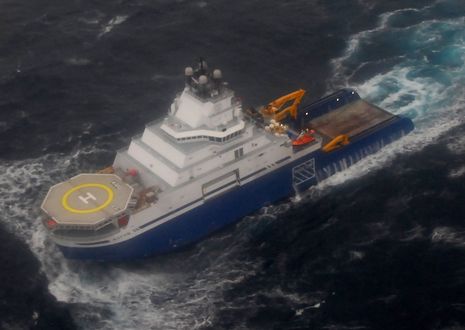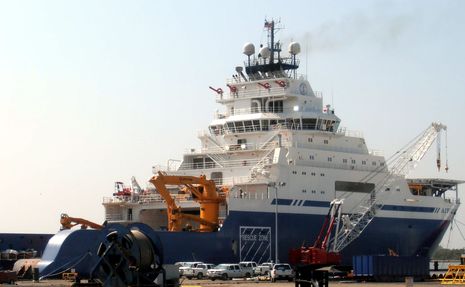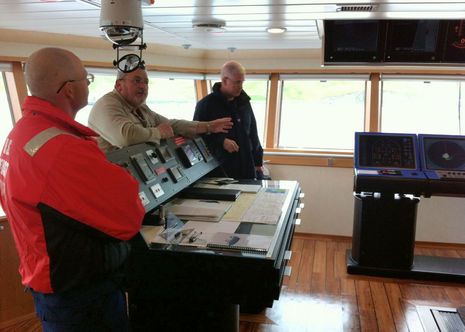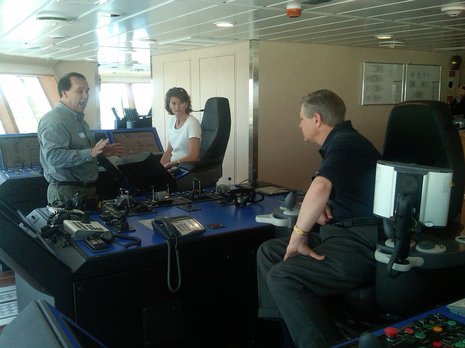The mighty Aiviq; more bridge details please

When most of us were enjoying the holiday quite the sea drama was playing out off Kodiak, Alaska. Last Friday the mighty 360-foot icebreaking anchor-handling tug supply vessel Aiviq (above) "experienced multiple engine failures" while towing the unusual conical drill ship Kulluk in 20-foot seas. Assisted by several large tugs and especially U.S. Coast Guard cutters and helicopters, the Aiviq eventually got her fuel issues solved and by Monday the Kulluk was back under tow, though without a crew and in even worse weather. And then the story turned again: The Aiviq's tow line parted, the CG ordered the tug Alert to drop hers for the crew's safety, and by New Year champagne time the Kulluk was hard aground being pounded by 30-foot waves...
This story is being well covered at gCaptain.com, and as a Coast Guard spokesman said, ""We are now entering into the salvage and possible spill-response phase of this event." I'll also note that U.S. Rep. Ed Markey added, "Oil companies keep saying they can conquer the Arctic, but the Arctic keeps disagreeing with the oil companies." I certainly hope the salvage operation goes well, and also that there will be some good reporting on what went on aboard these vessels during this challenging time. But I've also become intrigued with Aiviq, which was only launched about a year ago...

Holy cow, what a workboat! If you click on the photo above (or the even higher res versions at 7seasvessels) you'll better appreciate her scale relative to that fleet of pickup trucks. I was also pleased to find a detailed Aiviq profile posted by Professional Mariner. But what I can't find are comprehensive photos of that huge wrap-around bridge or deep details about the electronics in use there. The PM article lists some gear like Maris ECDIS 900, JRC 7100 Series radars, Marine Technologies AP and DP, and Furuno goodies like the FE-700 sounder and DS-800 doppler log. Furuno also got tapped for its Felcom 15 Inmarsat C GMDSS system and FM-8800 VHF sets, but what the heck is in all those big domes?

Meanwhile I found the USCG photo above -- taken while Capt. Borkowski (center) delivers a tour -- and it hints at a clean, modern bridge design with oodles of tech and some more traditional gear like that overhead bearing compass with mirror and magnifying glass. There's also the shot below of Alaska Senator Lisa Murkowski trying out what appears to be the driver's seat. Actually Aiviq has eight steering stations according to PM, but how about all those thruster and nozzle levers! And wouldn't it be interesting to see what's on all those screens?
This is an amazing boat that just had a bad week. The last time I wrote about a mega workboat, the master eventually got in touch. Here's hoping that life aboard Aiviq becomes peaceful again, and that someone will send more pictures and details about her bridge.


 Share
Share
Understand that the "drill ship" Kulluk has no propulsion, not even dynamic positioning (which may not cut it in the far north ice anyway). I can't find the size for the 12 anchors but the winches each have the capacity to handle 3,763 feet of 3.5-inch 573 ton breaking strength wire!
So try to imagine the Aiviq's job of deploying those anchors in the Arctic. When I spent a few months in 1973 aboard a 180-foot supply boat off Texas we sometimes hosted anchor crews and it was hairy. The forces involved and the rig/boat/team coordination required were big time, and that was toy scale relative to what this boat does.
By the way, Aiviq is rated as able to run through one meter of ice and has "heeling pumps" to help, which I'd really like to understand.